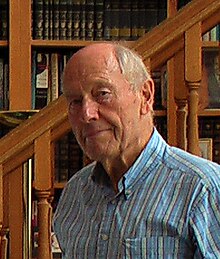David W. Allan
David Wayne Allan (born September 25, 1936 in Mapleton, Utah) is an American physicist, best known for his contributions to atomic clocks .
Allan studied physics at Brigham Young University with a bachelor's degree in 1960 and at the University of Colorado with a master's degree in 1965. From 1960 he was in the Frequency and Time Standards Department of the National Bureau of Standards (NBS, later NIST) in Boulder in Colorado. From 1979 to 1988 he was head of the Time and Frequency Coordination Group. In 1992 he officially retired (as a Senior Scientist) and moved to Utah ( Fountain Green (Utah) ).
From 1962 he worked on the uniform time standard of the USA, which he also coordinated with international time standards, as head of the corresponding group at NIST. The time measurement algorithm he wrote in 1968 is still the basis of the time standards of NIST and Coordinated Universal Time (UTC, via the Algos algorithm, which uses the ideas of Allan's algorithm). A measure for the frequency stability in clocks and oscillators is named after him ( Allan variance or two sample variance ).
In 1968 he received the US Department of Commerce Silver Medal for contributions to the NBS atomic time standards and understanding of the statistics of atomic frequency standards. In 1976 he received the IR-100 Award. He also received an Air Force Invention Award. He was co-editor of the IEEE's Frequency & Time magazine .
He was an advisor to the Indian government in New Delhi (for the UN Development Program 1981) and visiting professor in China (1982) and Italy (Istituto Elettrotecnico Nazionale Galileo Ferraris in Turin, 1969) and in 1987 in Israel (National Physical Laboratory). In 1985 he was a visiting scientist at the symposium of the International Astronomical Union in Leningrad. He also advised on issues relating to atomic time during the introduction of the Global Positioning System in the USA and with the Deep Space Network (DSN).
In 1984 he received the II Rabi Award .
He has been married since 1959 and has seven children. Allan is a Mormon.
Web links
Individual evidence
- ↑ Birth and career dates Pamela Kalte u. a. American Men and Women of Science , Thomson Gale 2004
- ↑ Allan, The statistics of atomic frequency standards, Proc. IEEE, Vol. 54, 1966, pp. 221-230
| personal data | |
|---|---|
| SURNAME | Allan, David W. |
| ALTERNATIVE NAMES | Allan, David Wayne (full name) |
| BRIEF DESCRIPTION | American physicist |
| DATE OF BIRTH | September 25, 1936 |
| PLACE OF BIRTH | Mapleton, Utah |
